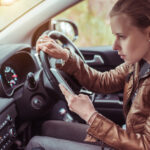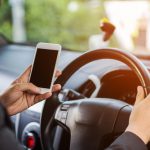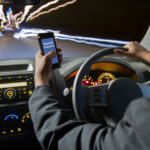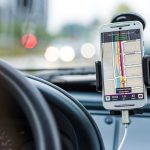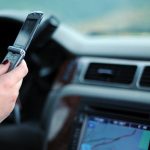Driving While Using iPads, iPods, TVs, CBs, Sat Navs and Phones in NSW: What Does the Law Say?
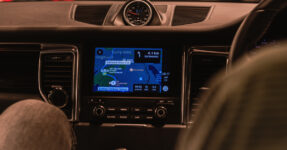
The law can be a complex beast, and one of the most confusing are indeed inconsistent areas is traffic law in New South Wales.
We recently posted an article about the fact that using Bluetooth to stream music while driving is illegal for restricted licence holders, and it prompted a number of questions about the use of iPods, iPads and also GPS systems, like Satellite Navigation.
So let’s have a look at what the road rules say.
Mobile phone use while driving in New South Wales
Under regulations 300 (fully licensed drivers) and 300-1 (restricted drivers) of the New South Wales Road Rules, it is illegal for a person to hold or even touch a phone while driving or riding – the exception being passing the phone to a passenger.
This encompasses all phone functions – including checking a message or social media, entering data, streaming music, getting directions, speed information or live traffic updates, and even turning the phone off.
Disobeying the rules attracts a $349 fine and 5 demerit points.
The exceptions for fully licensed drivers
However, regulation 300 makes clear that the rule does not apply where a vehicle is parked (not merely stationary) or where:
(a) the phone is being used to make or receive an audio phone call or to perform an audio playing function and the body of the phone:
- is secured in a mounting affixed to the vehicle while being so used, or
- is not secured in a mounting affixed to the vehicle and is not being held by the driver, and the use of the phone does not require the driver, at any time while using it, to press any thing on the body of the phone or to otherwise manipulate any part of the body of the phone, or
(b) the phone is functioning as a visual display unit that is being used as a driver’s aid and the phone is secured in a mounting affixed to the vehicle, or
(c) the vehicle is an emergency vehicle or a police vehicle, or
(d) the driver is otherwise exempt from the rule under another law.
A visual display unit used as a driver’s aid includes:
- Closed-circuit television security cameras,
- Dispatch systems,
- Navigational or intelligent highway and vehicle system equipment,
- Rearview screens,
- Ticket-issuing machines, and
- Vehicle monitoring devices.
A further exception to the rule against using a mobile phone while driving or riding is where the vehicle is stationary in a road-related area (not on a road), and:
- is functioning as a payment device to enable the driver to pay for goods or services that are required to be paid for in the road related area, or
- is being used to display an electronic coupon, voucher, card or similar article that requires the body of the phone to be held in close proximity to another device located in the road related area in order for the article to be used or redeemed, or
- is being used as an electronic device that enables the driver to enter another road related area or land adjacent to the road related area.
A ‘road related area’ is defines as:
- an area that divides a road
- a footpath or nature strip adjacent to a road
- an area that is open to the public and is designated for use by cyclists or animals
- an area that is not a road and that is open to or used by the public for driving, riding or parking vehicles
- a shoulder of a road, or
- any other area that is open to or used by the public and that has been declared under to be an area to which specified provisions of the Road Transport Act or the statutory rules apply.
This includes drive through establishments.
Restricted licence holders
The rules which apply to Learner drivers and riders, and those on P1 and P2 plates, are stricter.
Regulation 300-1 makes clear that restricted drivers and riders are prohibited from using a mobile phone unless parked (not merely stationary) or if they are stationary in a road-related area (not on a road), and the phone:
- is functioning as a payment device to enable the driver to pay for goods or services that are required to be paid for in the road related area, or
- is being used to display an electronic coupon, voucher, card or similar article that requires the body of the phone to be held in close proximity to another device located in the road related area in order for the article to be used or redeemed, or
- is being used as an electronic device that enables the driver to enter another road related area or land adjacent to the road related area.
Other devices
There are a number of rules which are hard to reconcile with one another, or with the overriding objective of road safety, when it comes to other devices.
Before those rules are outlined, it is important to emphasise that the use of any device is subject to the ‘catch-all’ provisions contained in regulation 297, including that ‘a driver must not drive a vehicle unless the driver has proper control of the vehicle’, and the driver must have a ‘clear view of the road, and traffic, ahead, behind and to each side of the driver’.
That said, here’s a summary of the rules (or lack thereof) relating to specific devices:
CB radios
There is no rule in New South Wales which specifically prohibits the use of CB radios while driving, even if the driver is holds the handset.
iPods
Similarly, there is no specific rule in our state against the use of dedicated portable music players such as iPods while driving.
Using maps in phones
It is legal for fully licensed drivers to touch a phone that is secured in a cradle which is fixed to the vehicle for the purpose of using aids to driving, such as satellite navigation systems.
Restricted licence holders such as Learners and P-Platers are prohibited from touching their phones for this purpose, even if the phone is properly mounted.
Using Sat Navs such as TomToms and NavMans
It is legal for drivers, including restricted drivers, to use (including touch) dedicated satellite navigation devices provided the device is “secured in a mounting affixed to the vehicle while being used”.
Using in-built navigation systems
It is legal for drivers, including restricted drivers, to use (including touch) satellite navigation systems that are “an integrated part of the vehicle design”.
Televisions and other visual displays
Regulation 299 makes clear that it is illegal to drive a vehicle that has a television receiver or visual display unit while the vehicle is moving, or is stationary but not parked, if any part of the image on the screen is visible to the driver from the normal driving position, or is likely to distract another driver.
This means it is against the law for a driver to permit a person in the passenger seat to watch a movie or otherwise use the device as a visual display, if it is visible to the driver.
iPads
It is legal to use iPads for the specific purpose of navigating while driving, provided the device is secured in a mounting fixed to the vehicle and does not obscure the driver’s view of the road.
It is illegal to use the device as a television receiver or other visual display, as per the rule above.
So there you have it, an outline of the rules relating to various devices – which are subject to the ‘catch-all’ provisions in regulation 297 of course.
The dangers of ‘distraction’
Studies show that if you take your eyes off the road for just two seconds to look at your phone and you’re driving at 40 km/h, it’s the equivalent of driving about 20 metres with your eyes closed – about the length of a cricket pitch.
At 80km/h it’s double that distance, and has the potential for disastrous effects.
According to data from Transport NSW, since 2012, there have been 202 casualty crashes involving a driver/rider using a hand held mobile phone – resulting in 18 deaths and 271 injuries.
This is based on preliminary data available as at 1 September 2020.
The numbers are considered to be under-reported because of the difficulty of finding evidence of illegal mobile phone use at crash scenes.
From July 2019 to June 2020, more than 62,400 fines were issued to drivers and riders in NSW for illegally using hand-held mobile phones while driving or riding, which means that the problem is prevalent.
Mobile phone detection cameras
In 2019, the New South Wales Government spent millions of dollars installing high-tech high-definition cameras for the purpose of detecting illegal mobile phone use on the road.
The government says these cameras are so sophisticated they are able to capture clear images of the front seats of vehicles as they drive past, catching drivers at night, in poor weather conditions and at speeds of up to 300km/h.
There are no warning signs to alert drivers to the presence of mobile detection cameras and the fines are the same whether you are caught by a camera, or pulled over by a police officer.
Going to court for a traffic offence?
If you are going to court for a traffic offence, call or email Sydney Criminal Lawyers anytime to arrange a free first consultation with an experienced, specialist traffic lawyer who will accurately advise you of your options, the best way forward, and fight for the optimal outcome in your specific situation.



